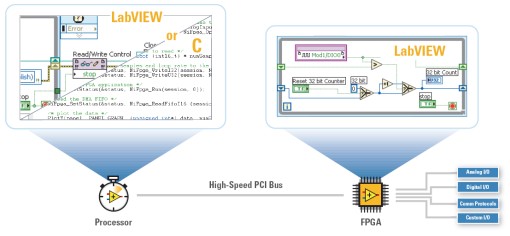Introduction to the FPGA Interface C API
Overview
With the FPGA Interface C API, developers can use LabVIEW graphical tools to program the field-programmable gate array (FPGA) within NI hardware and choose either LabVIEW or C/C++ tools to program the processor within the system. This gives engineers and scientists with C expertise the ability to take advantage of FPGAs within their designs without the burden of learning hardware design while also giving them the option to reuse their existing embedded C code.
Contents
FPGA Interface C API
With the FPGA Interface C API, engineers and scientists can program the real-time processor on NI FPGA-based hardware using the C/C++ IDE of their choice and interface to the LabVIEW FPGA code running on the FPGA. Developers also can program the processor using the LabVIEW Real-Time Module, which includes tools for low-level system debugging and precision execution timing for increased flexibility and functionality of deterministic real-time applications.
The FPGA Interface C API includes nearly all the same functionality as the existing LabVIEW host interface, including the ability to read and write FPGA front panel controls, target-to-host and host-to-target DMA streaming, and IRQ assertion and acknowledgement.
Using the FPGA Interface C API
The following steps outline the development process. For detailed instructions, refer to the FPGA Interface C API Help documentation:
- Develop and compile your LabVIEW FPGA VI. This produces a bitfile.
- Launch the FPGA Interface C API generator. Based on the bitfile, a C header file is generated.
- Include the header file in your C/C++ application.
- Build and deploy the application to the embedded target.
Download Required Software
Required software for FPGA development:
- LabVIEW (Full or above)
- LabVIEW FPGA Module
- NI RIO Device Drivers
Required software for C application development:
Optional software for application development
Learn More
» View the tutorial for building a FPGA host application in LabWindows™/CVI
» Access the FPGA Interface C API Help Documentation
» Learn more about C/C++ Embedded System Design Tools
» Learn more about NI R Series multifunction RIO
